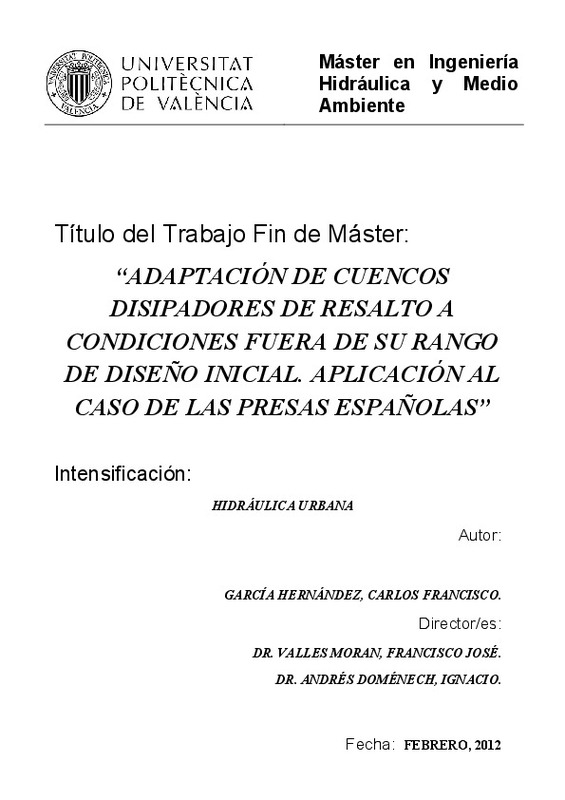|
Resumen:
|
[ES] La normativa en relación a la seguridad de presas y embalses es cada vez más exigente, obligando
en muchos casos a la ampliación del aliviadero existente. De donde se tiene que la seguridad ante la
inundación por ...[+]
[ES] La normativa en relación a la seguridad de presas y embalses es cada vez más exigente, obligando
en muchos casos a la ampliación del aliviadero existente. De donde se tiene que la seguridad ante la
inundación por la descarga y a la disipación de energía en presas de gravedad vertedero, es un tema
muy importante en la ingeniería hidráulica, especialmente en los casos de altura de caída y de
caudales específicos elevados, por lo que para el diseño de estas presas se debe de asumir una
gran importancia en el diseño del aliviadero y del cuenco disipador de energía.
Una solución propuesta, para el diseño, es el uso del ábaco para la elección y predimensionamiento
del cuenco amortiguador tipificado, con la que se podrá elegir el tipo de cuenco amortiguador
tipificado más adecuado que debe utilizarse, así como para comprobar la validez del cuenco
tipificado existente de una presa. Además, para los casos en los que no sea conveniente utilizar un
cuenco tipificado, se utilizará la aireación artificial para modificar las características originales del
flujo a la entrada del cuenco y con la ayuda de la gráfica de la curva de cavitación se podrá conocer
de forma anticipada las presas que pueden estar propensas a la aparición de daños por cavitación.
Por lo que se concluye, en relación a los resultados obtenidos del presente trabajo para el caso del
diagnóstico de las presas españolas de gravedad vertedero inventariadas, que la aplicación del
ábaco para la elección y predimensionamiento de los cuencos amortiguadores tipificados constituye
una herramienta sencilla y robusta para la comprobación de la buena elección y el correcto
funcionamiento del cuenco tipificado existente de una determinada presa. Y en relación a la
adaptación de los casos fuera de su rango de funcionamiento, se ha demostrado teóricamente que
con el uso de la aireación artificial se pueden modificar las características originales del flujo a la
entrada del cuenco. De este modo, actuando sobre la aireación, se puede conseguir desplazar el
punto a la zona de no cavitación, e incluso, llevarlo a la zona de funcionamiento de los cuencos
tipificados.
[-]
[EN] The regulations concerning the safety of dams and reservoirs is increasingly demanding, often
requiring the extension of the existing spillway. Where security has to be before the flood discharge
and energy dissipation ...[+]
[EN] The regulations concerning the safety of dams and reservoirs is increasingly demanding, often
requiring the extension of the existing spillway. Where security has to be before the flood discharge
and energy dissipation in gravity dams landfill is a major issue in hydraulic engineering, especially
Máster en Ingeniería
Hidráulica y Medio
Ambiente
in cases of drop height and high specific flow, so that for the design of these dams should assume a
great importance in the design of the spillway and the energy dissipator.
One proposed solution for the design is the use of the abacus to the election and pre-dimensioning
of the stilling basin typified, with which you can choose the type of stilling basin typified most
suitable to be used, as well as checking the validity of the stilling basin typified an existing dam.
Further, for cases in which it is not convenient to use a stilling basin typified be used artificial
aeration to modify the original characteristics of the flow at the entrance of the stilling basin and with
the aid of the curve graph of cavitation can be known so early dams may be prone to the occurrence
of cavitation damage.
As concluded in relation to the results of this study for the case of diagnosis of the Spanish gravity
dams spillway recorded, that implementation of the abacus to the election and pre-dimensioning of
the stilling basins typified is a simple and robust for testing the right choice and proper functioning
of the stilling basins typified existing in a particular dam. And in relation to the adaptation of cases
outside its operating range, has been shown theoretically that with the use of artificial aeration can
modify the original characteristics of the flow at the entrance of the stilling basin. Thus, by acting on
the aeration may be achieved to move the point of no cavitation zone, and even bring it to the
operating area of the stilling basins typified.
[-]
|







